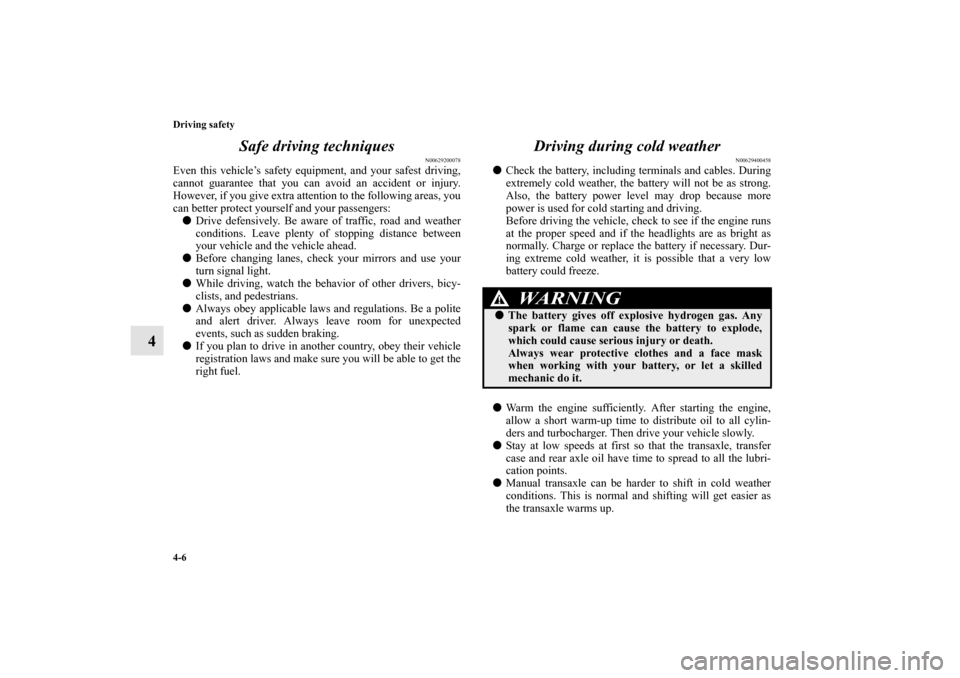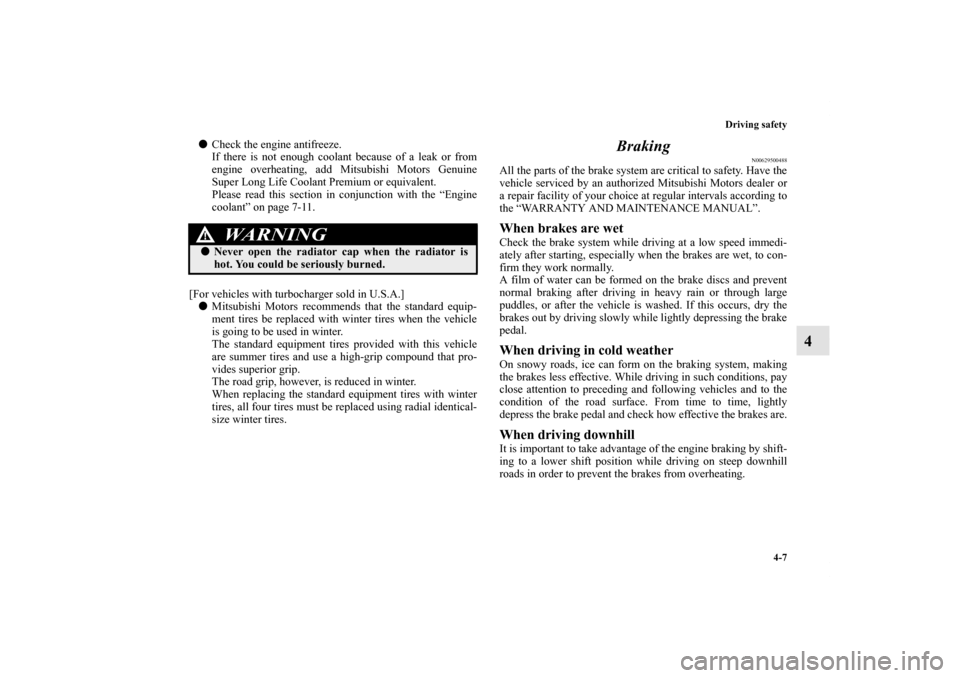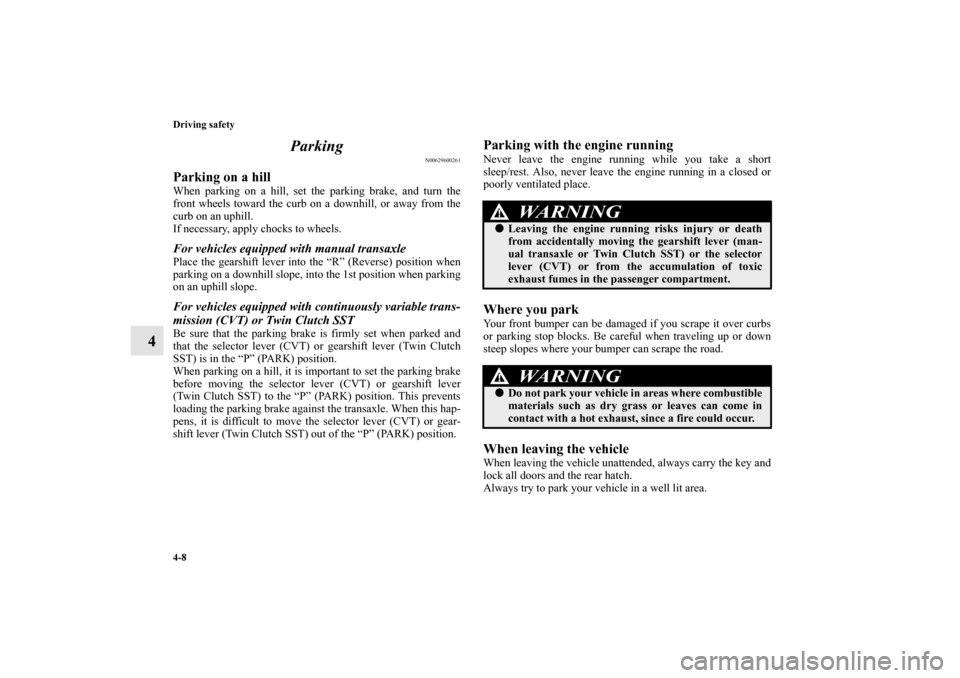Page 401 of 706
4-4 Driving safety
4
�Always install the mat with the correct side facing
down.�Never install a second mat over or under an existing
floor mat.�Do not use a floor mat designed for another model
vehicle even if it is a Mitsubishi genuine floor mat.�Before driving, be sure to check the following:
• Periodically check that the floor mat is properly
secured with the retaining clips.
If you remove the floor mat while cleaning the
inside of your vehicle or for any other reason,
always check the condition of the floor mat after it
has been reinstalled.
• While the vehicle is stopped with the engine off,
check that the floor mat is not interfering with the
pedals by depressing the pedals fully.WA R N I N G
!
BK0151000US.book 4 ページ 2012年3月29日 木曜日 午後6時8分
Page 403 of 706

4-6 Driving safety
4Safe driving techniques
N00629200078
Even this vehicle’s safety equipment, and your safest driving,
cannot guarantee that you can avoid an accident or injury.
However, if you give extra attention to the following areas, you
can better protect yourself and your passengers:
�Drive defensively. Be aware of traffic, road and weather
conditions. Leave plenty of stopping distance between
your vehicle and the vehicle ahead.
�Before changing lanes, check your mirrors and use your
turn signal light.
�While driving, watch the behavior of other drivers, bicy-
clists, and pedestrians.
�Always obey applicable laws and regulations. Be a polite
and alert driver. Always leave room for unexpected
events, such as sudden braking.
�If you plan to drive in another country, obey their vehicle
registration laws and make sure you will be able to get the
right fuel.
Driving during cold weather
N00629400458
�Check the battery, including terminals and cables. During
extremely cold weather, the battery will not be as strong.
Also, the battery power level may drop because more
power is used for cold starting and driving.
Before driving the vehicle, check to see if the engine runs
at the proper speed and if the headlights are as bright as
normally. Charge or replace the battery if necessary. Dur-
ing extreme cold weather, it is possible that a very low
battery could freeze.
�Warm the engine sufficiently. After starting the engine,
allow a short warm-up time to distribute oil to all cylin-
ders and turbocharger. Then drive your vehicle slowly.
�Stay at low speeds at first so that the transaxle, transfer
case and rear axle oil have time to spread to all the lubri-
cation points.
�Manual transaxle can be harder to shift in cold weather
conditions. This is normal and shifting will get easier as
the transaxle warms up.
WA R N I N G
!�The battery gives off explosive hydrogen gas. Any
spark or flame can cause the battery to explode,
which could cause serious injury or death.
Always wear protective clothes and a face mask
when working with your battery, or let a skilled
mechanic do it.
BK0151000US.book 6 ページ 2012年3月29日 木曜日 午後6時8分
Page 404 of 706

Driving safety
4-7
4
�Check the engine antifreeze.
If there is not enough coolant because of a leak or from
engine overheating, add Mitsubishi Motors Genuine
Super Long Life Coolant Premium or equivalent.
Please read this section in conjunction with the “Engine
coolant” on page 7-11.
[For vehicles with turbocharger sold in U.S.A.]
�Mitsubishi Motors recommends that the standard equip-
ment tires be replaced with winter tires when the vehicle
is going to be used in winter.
The standard equipment tires provided with this vehicle
are summer tires and use a high-grip compound that pro-
vides superior grip.
The road grip, however, is reduced in winter.
When replacing the standard equipment tires with winter
tires, all four tires must be replaced using radial identical-
size winter tires.
Braking
N00629500488
All the parts of the brake system are critical to safety. Have the
vehicle serviced by an authorized Mitsubishi Motors dealer or
a repair facility of your choice at regular intervals according to
the “WARRANTY AND MAINTENANCE MANUAL”.When brakes are wetCheck the brake system while driving at a low speed immedi-
ately after starting, especially when the brakes are wet, to con-
firm they work normally.
A film of water can be formed on the brake discs and prevent
normal braking after driving in heavy rain or through large
puddles, or after the vehicle is washed. If this occurs, dry the
brakes out by driving slowly while lightly depressing the brake
pedal.When driving in cold weatherOn snowy roads, ice can form on the braking system, making
the brakes less effective. While driving in such conditions, pay
close attention to preceding and following vehicles and to the
condition of the road surface. From time to time, lightly
depress the brake pedal and check how effective the brakes are.When driving downhillIt is important to take advantage of the engine braking by shift-
ing to a lower shift position while driving on steep downhill
roads in order to prevent the brakes from overheating.
WA R N I N G
!�Never open the radiator cap when the radiator is
hot. You could be seriously burned.
BK0151000US.book 7 ページ 2012年3月29日 木曜日 午後6時8分
Page 405 of 706

4-8 Driving safety
4Parking
N00629600261
Parking on a hillWhen parking on a hill, set the parking brake, and turn the
front wheels toward the curb on a downhill, or away from the
curb on an uphill.
If necessary, apply chocks to wheels.For vehicles equipped with manual transaxlePlace the gearshift lever into the “R” (Reverse) position when
parking on a downhill slope, into the 1st position when parking
on an uphill slope.For vehicles equipped with continuously variable trans-
mission (CVT) or Twin Clutch SSTBe sure that the parking brake is firmly set when parked and
that the selector lever (CVT) or gearshift lever (Twin Clutch
SST) is in the “P” (PARK) position.
When parking on a hill, it is important to set the parking brake
before moving the selector lever (CVT) or gearshift lever
(Twin Clutch SST) to the “P” (PARK) position. This prevents
loading the parking brake against the transaxle. When this hap-
pens, it is difficult to move the selector lever (CVT) or gear-
shift lever (Twin Clutch SST) out of the “P” (PARK) position.
Parking with the engine runningNever leave the engine running while you take a short
sleep/rest. Also, never leave the engine running in a closed or
poorly ventilated place.Where you parkYour front bumper can be damaged if you scrape it over curbs
or parking stop blocks. Be careful when traveling up or down
steep slopes where your bumper can scrape the road.When leaving the vehicleWhen leaving the vehicle unattended, always carry the key and
lock all doors and the rear hatch.
Always try to park your vehicle in a well lit area.
WA R N I N G
!�Leaving the engine running risks injury or death
from accidentally moving the gearshift lever (man-
ual transaxle or Twin Clutch SST) or the selector
lever (CVT) or from the accumulation of toxic
exhaust fumes in the passenger compartment.
WA R N I N G
!�Do not park your vehicle in areas where combustible
materials such as dry grass or leaves can come in
contact with a hot exhaust, since a fire could occur.
BK0151000US.book 8 ページ 2012年3月29日 木曜日 午後6時8分
Page 419 of 706
5-6 Comfort controls
5Manual air conditioning with MAX A/C
mode
(if so equipped)
N00730300315
The air conditioning can only be used while the engine is run-
ning.Control panel
N00730500274
Blower speed selection dial
N00736500146
When the ignition switch is in the “ON” position, select the
blower speed by turning the blower speed selection dial.
Turning the dial clockwise will increase the blower speed;
turning the dial counterclockwise will decrease it. When the
dial is set to the “OFF” position, all fan-driven airflow will
stop.
A- Temperature control dial
B- Air selection switch
C- Blower speed selection dial
D- Air conditioning switch
E- Mode selection dial
F- Electric rear window defogger switch → P.3-251
BK0151000US.book 6 ページ 2012年3月29日 木曜日 午後6時8分
Page 420 of 706
Comfort controls
5-7
5
Temperature control dial
N00736600219
Turn the temperature control dial clockwise to make the air
warmer. Turn it counterclockwise to make the air cooler.NOTE�While the engine coolant temperature is low, the tempera-
ture of the air from the heater will be cool/cold until the
engine warms up, even if you have selected warm air with
the dial.
�For instructions on how to use the “MAX A/C” position
(A), refer to “For quick cooling” on page 5-12.
Mode selection dial
N00736700151
To change the amount of air flowing from the vents, turn the
mode selection dial. Refer to “Changing the mode selection”
on page 5-3.
BK0151000US.book 7 ページ 2012年3月29日 木曜日 午後6時8分
Page 429 of 706
5-16 Comfort controls
5Manual air conditioning without MAX A/C
mode
(if so equipped)
N00730300269
The air conditioning can only be used while the engine is run-
ning.Control panel
N00730500287
Blower speed selection dial
N00736500133
When the ignition switch is in the “ON” position, select the
blower speed by turning the blower speed selection dial.
Turning the dial clockwise will increase the blower speed;
turning the dial counterclockwise will decrease it. When the
dial is set to the “OFF” position, all fan-driven airflow will
stop.
A- Temperature control dial
B- Air selection switch
C- Blower speed selection dial
D- Air conditioning switch
E- Mode selection dial
F- Electric rear window defogger switch → P.3-251
BK0151000US.book 16 ページ 2012年3月29日 木曜日 午後6時8分
Page 430 of 706
Comfort controls
5-17
5
Temperature control dial
N00736600176
Turn the temperature control dial clockwise to make the air
warmer. Turn it counterclockwise to make the air cooler.NOTE�While the engine coolant temperature is low, the tempera-
ture of the air from the heater will be cool/cold until the
engine warms up, even if you have selected warm air with
the dial.
Mode selection dial
N00736700177
To change the amount of air flowing from the vents, turn the
mode selection dial. Refer to “Changing the mode selection”
on page 5-3.
BK0151000US.book 17 ページ 2012年3月29日 木曜日 午後6時8分